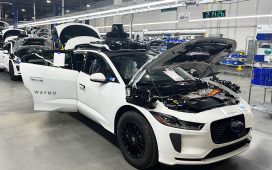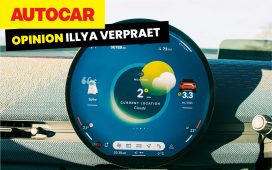For all the excitement over huge gigafactories churning out millions of solar panels, electric vehicles and other clean tech items, the future of sustainable manufacturing could belong to the microfactory model. Small-scale, local, on-demand, customized production facilities could reduce waste, cut the impacts of transportation and commuting, and take better advantage of local renewable energy systems along with scooping up opportunities to repurpose existing buildings and brownfields. With that in mind, let’s take a look at the new 3D weaving machine from the Bay Area startup unspun.
A waste-free 3D weaving microfactory could be coming soon to a neighborhood near you (photo courtesy of unspun).
3D Precision Fitting Good …
The problem of waste in the fashion industry has been receiving a lot of attention of late, and for good reason.
“Each year millions of tonnes of clothes are produced, worn, and thrown away,” notes the non-profit organization Ellen MacArthur Foundation. “Every second, the equivalent of a rubbish truck load of clothes is burnt or buried in landfill.”
“The fashion industry is one of the major contributors of plastic microfibres entering our oceans. To solve the problem, we must reinvent fashion itself,” they add.
A good deal of that waste happens at the consumer end, when people throw out clothes that still have some wearable life in them. The United Nations Environmental Programme states that “the number of times a garment is worn has declined by 36 per cent in 15 years,” indicating the increasing grip of throwaway culture on fashion.
Unspun launched in 2015 with an initial mission to help reduce waste at the consumer end. The company leverages 3D scanning to precisely fit jeans for individual buyers, and manufactures them on demand. Between the custom fit and the high but relatively affordable price tag of $200 or so, presumably consumers would be motivated to keep their jeans practically forever.
… 3D Weaving Better
Aside from motivating consumers to stop throwing away their clothes, the on-demand production model also practically eliminates the tremendous amount of waste that happens when retailers order too many items at the beginning of a season, only to throw out the unsold ones at the end.
Writing for ELUXE Magazine last year, reporter Chiara Spagnoli Gabardi drew an un-pretty picture of the unsold goods problem. Gabardi also provided an overview of recent e-commerce, technology and software improvements that can help reduce throwaways by enabling retailers to align their buys more closely with consumer demand.
Still, even if retailers and consumers can pair up in some form of supply-demand perfection, a staggering amount of waste will continue to occur on the production side, when scraps of fabric are discarded after patterns are cut. The Harvard Business School took stock of the fabric scrap situation in 2021 and cited this assessment:
“According to FabScrap, the nonprofit fabric up-cycler, ‘for every pound [of clothing fabric] that we throw away as a consumer, a business throws away 40 pounds.’”
That may sound somewhat exaggerated, but FabScrap’s assessment also includes whole rolls of unused fabric, in addition to leftover scraps from cutting. The discarded rolls account for about 60% of the total.
Unspun is now turning its attention to the fabric waste angle, with the launch of its new trademarked Vega 3D weaving machines. To get them off the ground, unspun has just raised $14 million in a Series A funding round led by firm Lowercarbon Capital, along with Climate Capital, SOSV, Signia Ventures and MVP Ventures. For those of you keeping score at home, a substantial number of previous investors are also on board, including Josh Buckley, Lachy Groom, 50Y, the Mills Fabrica, Novetex, and Straubel Foundation. The National Science Foundation also provided seed funding in 2018.
Microfactories For Sustainable Fashion
The new round of funding will “support implementation of unspun’s innovative 3D weaving technology Vega™, which will help brands realize a zero-inventory, onshored, circular and automated supply-chain for woven products,” unspun reports.
The 3D weaving machine is a robotics-enabled device inspired by additive manufacturing principles. It can weave a pair of pants to order in 10 minutes, from scratch. The 3D machine is fed directly with yarn. No fabric inputs are involved. According to unspun, just a few minutes’ worth of finishing steps are needed to complete the process.
If this is beginning to sound a bit like 3D printing, that’s the idea. Consolidating different fabrication steps into one machine that spits out products on demand is a space-saver, and unspun is aiming its 3D weaving machine at the microfactory model.
“By producing in micro-factories powered by Vega™, multiple traditional manufacturing steps—which result in high order quantities, long lead times, increased transport emissions, and excess inventory waste—are eliminated,” unspun explains.
“Producing in smaller batches allows brands to quickly react to market demands or even produce products on demand, eliminating the need for inventory altogether,” they add. “This approach not only reduces transport costs and emissions, but also creates a short and agile supply chain that requires little or no inventory.”
Unspun is a certified B Corporation, with the B standing for Benefit, meaning that it meets high standards for performance, accountability, and transparency. Aside from attracting investor interest, unspun has also caught the eye of Vogue 100 innovator’s list, Newsweek’s list of 13 Climate Change innovators, TIME’s Best Inventions, and Fast Company’s World-Changing Ideas.
The Microfactory Of The Future
To ice the green cake, unspun is investigating ways to retrieve and re-use yarn from finished garments. If the 3D weaving machines are yarn-agnostic, there could be other recycling pathways in the mix. We’re thinking that could include synthetic yarns made from recycled plastics, recycled carbon, and other waste sources.
If you have any other suggestions, drop us a note in the comment thread. Meanwhile, all this talk about 3D weaving and microfactories calls to mind the idea of producing a 3D-printed car in a microfactory.
Back in 2015, the US Department of Energy got behind a startup called Local Motors. The company aimed to produce customizable 3D-printed electric cars at small, local factories. The car-printing machine itself fits comfortably in a space approximately the size of a parking spot, so that’s not so far fetched.
Local Motors eventually gave up the ghost, but Local Motors is credited with inspiring initiatives like Canada’s Project Arrow electric concept car with a 3D-printed chassis.
A more recent example is the startup Arrival, which is producing its electric delivery vans with a software-driven microfactory model that incorporates in-house components, composite materials, and autonomous mobile robots.
In other microfactory news, earlier this year the leading supermarket company Southeastern Grocers Inc., which covers Fresco y Más, Harveys Supermarket, and Winn-Dixie, announced a hookedup with the startup Relocalize to pilot a first-in-the-world ice-making microfactory in Florida.
Building on SEG’s previous work with Relocalize on hyper-local food production, the ice-making project will “help eliminate middle-mile logistics to reduce global greenhouse gas emissions, water waste and plastic pollution to nourish both people and the planet,” said SEG, so stay tuned for more on that.
Find me on Spoutible: @TinaMCasey or LinkedIn @TinaMCasey or Mastodon @Casey or Post: @tinamcasey
Photo: 3D printing is the inspiration behind unspun’s new Vega 3D Weaving machines (screenshot courtesy of unspun).
Sign up for daily news updates from CleanTechnica on email. Or follow us on Google News!
Have a tip for CleanTechnica, want to advertise, or want to suggest a guest for our CleanTech Talk podcast? Contact us here.
Former Tesla Battery Expert Leading Lyten Into New Lithium-Sulfur Battery Era — Podcast:
I don’t like paywalls. You don’t like paywalls. Who likes paywalls? Here at CleanTechnica, we implemented a limited paywall for a while, but it always felt wrong — and it was always tough to decide what we should put behind there. In theory, your most exclusive and best content goes behind a paywall. But then fewer people read it! We just don’t like paywalls, and so we’ve decided to ditch ours.Unfortunately, the media business is still a tough, cut-throat business with tiny margins. It’s a never-ending Olympic challenge to stay above water or even perhaps — gasp — grow. So …









